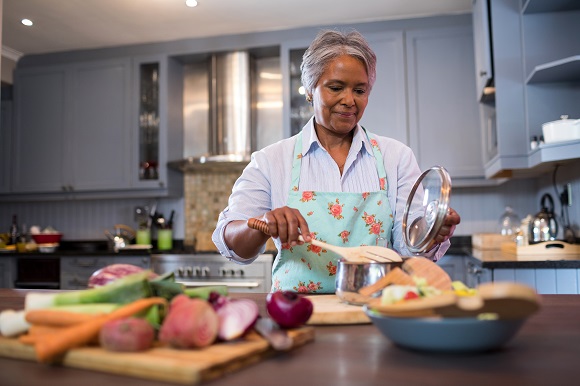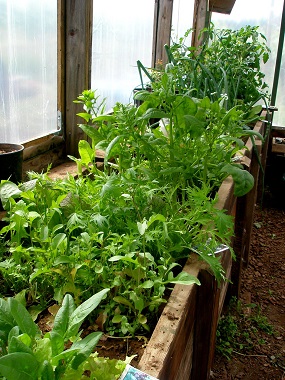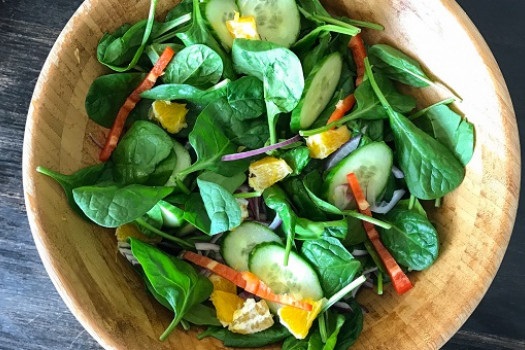In this edition
- Steps to Food Safety
- July is Parks and Recreation Month
- Growing Salads Greens
- Super Salad Toppers
- Food Safety with Salads
- Sunshine Salad
About the Newsletter
In this edition, we cover the topic of food safety, celebrate Parks and Recreation Month, explore ways to make salads more exciting, and feature a wonderful sunshine salad recipe perfect to enjoy this summer!
Steps to Food Safety
An interview with Elizabeth Mapula
For more about food preservation as a way to safely
store food, email mapulae@unr.edu.

Woman cooking in kitchen.
UNR Extension’s Healthy Aging team (HA) spoke with Elizabeth Mapula (EM), Healthy Food Systems program officer, to discuss questions frequently asked about food safety. More information on food safety: https://www.nifa.usda.gov/.
HA: What is Food Safety?
EM: Food safety are steps and procedures put in place to prevent cross contamination and foodborne illness from occurring and come from agencies such as the U.S. Department of Agriculture (USDA), U.S. Food and Drug Administration (FDA) and Centers for Disease Control and Prevention (CDC).
HA: How do I prevent cross contamination?
EM: Separate raw meat, poultry, seafood and eggs from ready-to-eat foods. Ready-to-eat foods should be stored on the top shelves of your refrigerator. Raw meat, poultry, seafood and eggs should be stored on the bottom shelves, in spill proof containers to prevent cross contamination. Use separate cutting boards for different food groups: fruits and vegetables, raw meat, poultry and seafood.
Wash cutting boards and utensils, such as knives or peelers, after every use to avoid cross contamination. Cross contamination can happen when the surfaces on which foods are prepared or served on are not clean.
HA: When do I refrigerate foods?
EM: Refrigerate perishable (fresh, spoilable) food within two hours. (If outdoor temperature is above 90°F, refrigerate within one hour.) Keep your refrigerator at 40°F or below. Know when to throw foods out by labeling your foods with the preparation date or purchase date. Also remember to label any take-out food. This date will let you know when to throw older food out.
HA: Should I rinse pre-packaged washed produce?
EM: No, prepackaged washed produce should NOT be washed again due to the higher risk of cross contamination. Only rinse fresh fruits and vegetables under running water, a vegetable brush can be used if needed.
HA: Should I wash poultry foods, such as chicken?
EM: No, do not wash the raw chicken or any poultry foods. Instead, take the poultry product out of the package and put it directly into a cooking pan. The heat from cooking will destroy bacteria and other harmful microorganisms that might be present. Washing can result in unintentional cross contamination to foods or clean surfaces. Use a food thermometer to ensure poultry foods have reached the internal cooking temperature of 165 degrees Fahrenheit.
HA: How do you safely reheat leftovers?
EM: When reheating, be sure leftovers reach 165 degrees Fahrenheit by using a food thermometer. Reheat sauces, soups and gravies by bringing them to a rolling boil. Covering leftovers to reheat helps retain moisture, ensuring that food will heat all the way through. Arrange food items evenly on a covered microwave safe glass or ceramic dish, add some liquid if needed, cover and rotate. Be sure the covering is microwave safe and vent the cover to let the steam escape. The moist heat that is created will help destroy harmful bacteria and will ensure uniform reheating.
HA: Is it safe to reheat frozen leftovers without thawing and then refreeze previously refrozen leftovers?
EM: It is safe to reheat leftovers, either in a saucepan or microwave. Reheating will take longer if the food is not thawed first. Sometimes there are leftover "leftovers" and it is safe to refreeze previously frozen leftovers. If a large container of leftovers was frozen and only a portion of it is needed, thaw the leftovers in the refrigerator, remove the needed portion and refreeze the remainder of the thawed leftovers. Be sure to label the food with the new refreezing date.
Elizabeth Mapula works at University of Nevada, Reno, College of Agriculture, Biotechnology and Natural Resources’ Extension. She is a certified master food preserver with the State of Nevada.
July is Parks and Recreation Month

Spring Mountain State Park, NV.
If you are 62 or older you can buy a lifetime pass to all National Parks for $80. Visit any National Park online or in person to purchase.
Enjoy Nevada and find a state park for every adventure by visiting Explore Nevada
Growing Salads Greens

Indoor vegetable garden growing in a planter box.
Salad greens are easy to grow in a home garden and an important source of vitamins and minerals. Dark green leaves are good sources of vitamins A and C, iron, folic acid and calcium. Iceberg is the most popular, but many other lettuces and salad such as spinach, arugula and romaine can add interest and nutrients to meals. Lettuce seeds can also be purchased using an EBT card!
LINK TO FURTHER INFORMATION...
Super Salad Toppers

Broccoli salad with blueberries and walnuts.
There are lots of nutritious ways to top a salad. Enhance eye appeal and nutrition by adding colorful fruits and vegetables. Keep it light by limiting the amount of salad dressing to about 1 tablespoon per 1½ to 2 cups of greens. Make the flavor pop by adding things like artichoke hearts, dried fruits, nuts, and/or seeds. Get creative with your toppers.
Link for more creative salad toppers ideas.
Food Safety with Salads

Knife with chopped chives.
Summer is a great time for salads and it’s important to store leafy greens at refrigerator temperatures and rinse well under running water before using. To reduce the risk of foodborne illness, observe “use by” dates printed on bagged leafy vegetables and salad mixes, using within two days after opening. Also, to keep calories lower, remember to “dress-not-drown” your salad in dressing. Try experimenting with different combinations of flavored oils and vinegars as well as herbs and spices for fun flavors this summer.
Link for more information on food safety.
Sunshine Salad

Sunshine Salad with spinach, cucumbers, bell peppers, and oranges.
Any way you toss it, oranges help to brighten up this tasty veggie salad. Celebrate National Salad week with a quick and easy to make spinach salad. Top it off with your favorite vinaigrette dressing and delicious salad toppers.
Link for more nutritional topics and other tasty summer recipes.
Ingredients:
- 5 cups spinach leaves, packed, washed and dried well
- ½ red onion, sliced thin
- ½ red pepper, sliced
- 1 cucumber, whole, sliced
- 2 oranges, peeled and chopped into bite-size pieces
- ⅓ cup vinaigrette “lite” dressing, 15 calories or less per tablespoon
Directions:
- Toss all ingredients together in a large bowl.
- Add dressing and toss again.
- Serve immediately.
For full nutritional information.


